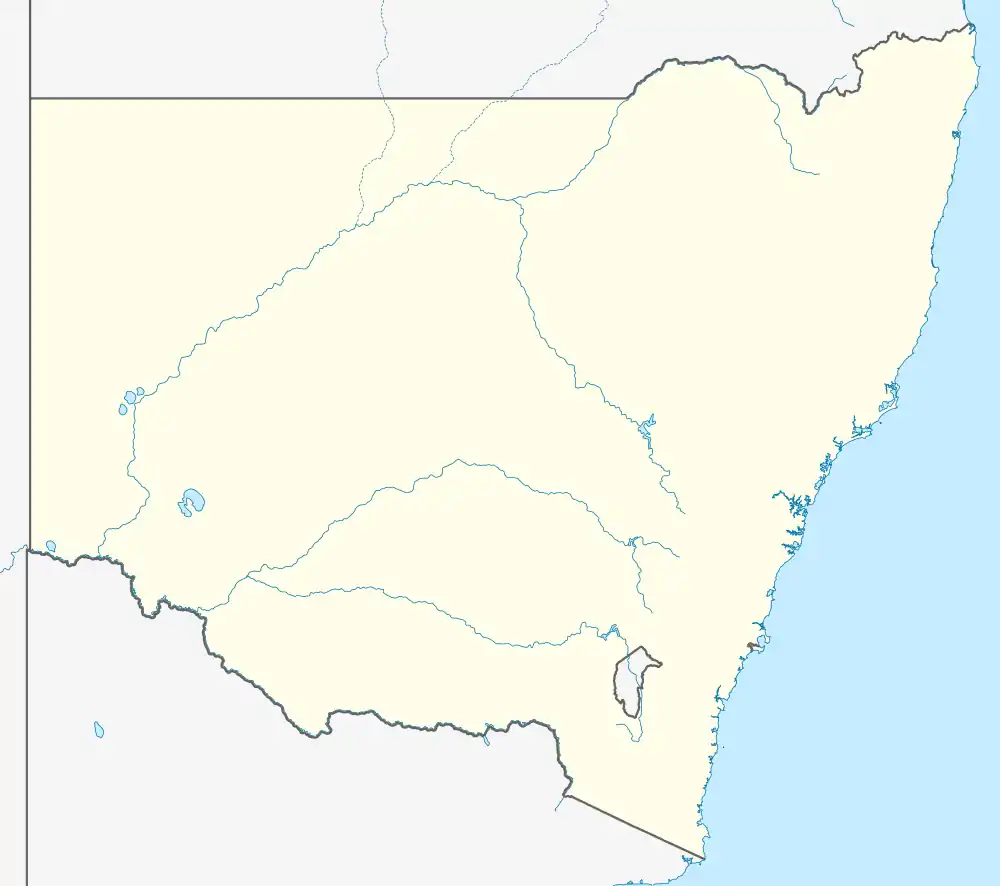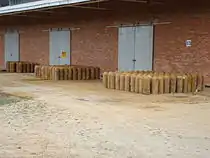Marrangaroo, New South Wales
Marrangaroo is a small town in the Central West of New South Wales, Australia in the City of Lithgow.
| Marrangaroo New South Wales | |||||||||
|---|---|---|---|---|---|---|---|---|---|
 Marrangaroo | |||||||||
| Coordinates | 33°26′0″S 150°07′0″E | ||||||||
| Population | 869 (2006 census)[1] | ||||||||
| Postcode(s) | 2790 | ||||||||
| Elevation | 1,200 m (3,937 ft) | ||||||||
| LGA(s) | City of Lithgow | ||||||||
| State electorate(s) | Bathurst | ||||||||
| Federal Division(s) | Calare | ||||||||
| |||||||||
Overview
Marrangaroo is located a few kilometres west of Lithgow. It is accessible from the Great Western Highway, and has no railway station and little bus services. Lithgow Buslines, run buses between Lithgow and Bathurst, which makes limited stops at Marrangaroo on the Great Western Highway. A main feature of Marrangaroo was the Trout Farm which was opposite the Lithgow Correctional Centre. At the 2006 census, Marrangaroo had a population of 869.[1]
Military

Marrangaroo Army Camp situated at the end of Reserve Road used to be a major ammunition depot from 1941 to the late 1980s. It was served by a three kilometres siding that branched off from the Main Western railway line from March 1942 until May 1988.[2] It is now used for demolitions and various training by all three Australian Defence Force services. During World War II it housed chemical warfare facilities; at the time, one of Australia's best kept secrets. Marrangaroo was the administration headquarters for all of the Royal Australian Air Force Chemical Weapon Stores which were kept in tunnels and sidings at Marrangaroo (old tunnel and siding near correctional centre), Glenbrook Tunnel in the Blue Mountains, Clarence Tunnel (that is now part of the Lithgow Zig Zag) and Picton tunnel in Sydney's south.[3]
During an interview with Plunkett in 2005, chemical warfare armourer, Geoff Burn mentioned he had been involved in the burial of 250 pounds (110 kg) phosgene bombs near the entrance to the headquarters in 1943. He was subsequently recalled from Cairns in 1944 to identify the site but was unsure as to whether and if the bombs had been extracted. After Burn marked the site on an aerial map a ground search revealed they were still there. The legacy of these weapons remains with several hundred empty chemical munition containers being found buried at Marrangaroo Army Camp from May 2008 to February 2009.[4][5]
A remediation project to remove heavy metal contamination started in November 2008 with a secondary task to remove any more buried chemical munitions. The revelation of Marrangaroo's history sparked significant local media interest.[6][7][8][9][10][11][12] The Department of Defence established a website for community consultation and feedback on the decontamination.[13]
Transport
.jpg.webp)
A railway station opened at Marrangaroo on the Main Western line in 1878 and closed in 1974. Little trace of it remains.[14] Also, it has been suggested as the western terminus for the proposed Bells Line Expressway. But this now unlikely to proceed. [15]
| Preceding station | Former Services | Following station | ||
|---|---|---|---|---|
| Wallerawang towards Bourke |
Main Western Line | Bowenfels towards Sydney | ||
Shale oil
During the calendar years 1943 to 1945 inclusive, Lithgow Oil Proprietary Ltd, at Marangaroo, produced around 2,000,000 gallons of crude shale oil. Under wartime conditions, that company had designed and constructed its own NTU retorts based on information from a Bureau of Mines publication. The crude shale oil was refined at the Glen Davis Shale Oil Works.[16][17] The Marangaroo oil shale deposit was small but exceptionally rich, assaying 237 gallons per long ton.[16]
Heritage listings
Marrangaroo has a number of heritage-listed sites, including:
- Main Western railway: Marrangaroo railway viaduct[18]
References
- Australian Bureau of Statistics (25 October 2007). "Marrangaroo (State Suburb)". 2006 Census QuickStats. Retrieved 27 October 2009.
- Marangaroo Railway Digest August 1988 page 312
- Plunkett, Geoff (2007). Chemical Warfare in Australia (PDF). Bayswater, Victoria: Shannon Books. ISBN 9781876439880. Retrieved 5 April 2012.
- Ashworth, Len (7 August 2008). "Base's phantom war reveals its secrets" (PDF). Lithgow Mercury. Retrieved 5 April 2012.
- Ashworth, Len (9 August 2008). "Chemical warfare left its legacy" (PDF). Lithgow Mercury. Retrieved 5 April 2012.
- Ashworth, Len (17 July 2008). "Chemical experiments in the Eighties". Lithgow Mercury. Archived from the original on 18 July 2012. Retrieved 5 April 2012.
- Ashworth, Len (17 July 2008). "Hidden Newnes Forest storage has added to military puzzle" (PDF). Lithgow Mercury. Archived from the original (PDF) on 18 July 2012. Retrieved 5 April 2012.
- Ashworth, Len (5 August 2008). "Railway historians join chemical warfare issue" (PDF). Lithgow Mercury. Retrieved 5 April 2012.
- Ashworth, Len (17 July 2008). "Chemical experiments in the Eighties" (PDF). Lithgow Mercury. Retrieved 5 April 2012.
- Ashworth, Len (8 July 2008). "Mustard gas tainted our reputation" (PDF). Lithgow Mercury. Retrieved 5 April 2012.
- Vollmer, Tim (22 September 2008). "Chemical bombs sit metres from Lithgow families for 60 years". The Daily Telegraph. Australia. Retrieved 5 April 2012.
- Geddes, Jeff (7 February 2009). "Cleansing our military 'sins'" (PDF). Lithgow Mercury. Retrieved 5 April 2012.
- "Marrangaroo Army Depot Environmental Remediation Project". Department of Defence. 6 August 2009. Retrieved 5 April 2012.
- "Marrangaroo station". NSWrail.net. Retrieved 8 August 2009.
- Bells Line of Road corridor improvement program Roads & Maritime 21 December 2017
- Kraemer, A.J.; Thorne, H.M. (July 1951). Oil Shale Operations in New South Wales, Australia (PDF). United States Department of the Interior. pp. 10, 11, 42. Retrieved 2 December 2012.
- "Lithgow Shale Oil Plant Closed Down". Newcastle Morning Herald & Miners' Advocate. 17 November 1945. p. 3. Retrieved 1 July 2020.
- "Marrangaroo railway viaduct". New South Wales State Heritage Register. Office of Environment and Heritage. H01046. Retrieved 18 May 2018.